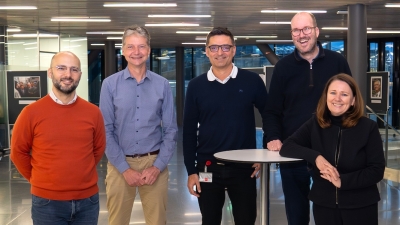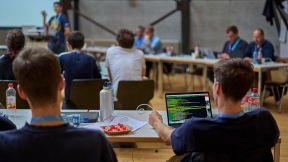тТЬВшжБВЅ Verify strengthens the image of our institutionт
The Geneva Graduate Institute recently introduced ТЬВшжБВЅ Verify. This enables the institute to digitally certify its master's and doctoral degrees. But its plans for the future go far beyond this. They reveal more in this interview.

ТЬВшжБВЅ: Can you briefly introduce us to the Geneva Graduate Institute?
The Geneva Graduate Institute: The Institute is a world-renowned academic research and training organisation founded in Geneva in 1927. As the world's first academic institution dedicated to international affairs, it offers master's and doctoral programmes in international law, international history and politics, international economics, international relations/political science, anthropology and sociology. The Institute also offers an interdisciplinary master's programme that draws on the expertise of these different disciplines. It accepts almost 1000 students from over 105 countries each year and employs around 600 staff, 400 of whom are dedicated to research and teaching. The research activities and expertise in these different areas are useful for governments, companies, basic research or teaching.
What steps were taken prior to the introduction of ТЬВшжБВЅ Verify to verify and authenticate the Institute's degrees and those of international institutions?
Every year, we receive around 150 requests from external bodies to verify diplomas submitted by candidates who are looking for work or continuing their studies. These checks take a lot of time.
What were your reasons for choosing and implementing ТЬВшжБВЅ Verify?
We were aware of the need to issue many official documents in a certified form whose authenticity can be independently verified. ТЬВшжБВЅ Verify enables us to digitally certify master's and doctoral degrees for students graduating in 2023. Now these students, as well as other organisations, can verify the authenticity of these documents themselves without having to rely on our internal resources.
This new and automated process enables both employers and students to speed up the job search process. The project also contributes to the digitalisation of the institute's processes and strengthens its image as an innovative and professional institution.
The choice of the ТЬВшжБВЅ Foundation as a historical partner of Swiss universities guarantees that the solution is recognised at the national level. In addition, ТЬВшжБВЅ Verify makes it possible to confirm the authenticity of diplomas or warn against forgeries.
What initial experiences have you had?
We have just introduced ТЬВшжБВЅ Verify and are very pleased with the feedback. We were familiar with blockchain-based technology because we had already received diplomas from other academic institutions that use this technology to certify and authenticate their diplomas. When ТЬВшжБВЅ presented their solution to us, we were already convinced of the benefits of ТЬВшжБВЅ Verify and quickly decided to implement this project.
Are you planning to extend the ТЬВшжБВЅ Verify solution to other use cases?
In fact, we are investigating the possibility of extending ТЬВшжБВЅ Verify to grade transcripts, and diplomas from continuing education programmes, but also to our employees' references. In a world where everything is moving faster and faster, we wanted to be the first academic institution in French-speaking Switzerland to implement this solution. Because we truly believe that this type of service offers added value to our students, employees and other organisations. On the other hand, we keep the diplomas certified with ТЬВшжБВЅ Verify in our student database (IS-Academia), which also allows us to move forward with the project of digitising student files.
How did the integration of ТЬВшжБВЅ Verify with Equinoxe, the publisher of the IS-Academia tool, go?
At the institute, the IT department and ТЬВшжБВЅ liaised with the student department to present the benefits of this new solution. The project was carried out in a cooperative and agile manner with ТЬВшжБВЅ, Equinoxe, the student department and the IT department.
IT wrote specifications and developed mockups to define a new portal for the certification of documents in IS-Academia. The collaboration with the Equinoxe development team was excellent, and technical or functional difficulties were solved professionally and efficiently.
A new portal was set up that could digitally verify and certify the diplomas with ТЬВшжБВЅ Verify. In order to implement the solution as quickly as possible, we decided not to integrate IS-Academia with ТЬВшжБВЅ Verify via an API, but to use ТЬВшжБВЅ Verify's web-based certification interface.
There were some teething problems with the ТЬВшжБВЅ Verify web interface, which ТЬВшжБВЅ was able to resolve quickly. In the course of development, we have improved the portal so that we will also be able to certify new types of documents such as transcripts of marks and others in the future.
Today we have entered the second phase of the project, in which we are integrating the ТЬВшжБВЅ Verify solution via API to further automate the certification process.
Have you received any initial feedback from your students since the introduction of ТЬВшжБВЅ Verify?
In fact, students appreciated having a certified digital version of their diploma sometime before the official graduation ceremony. The digital diploma enables them to apply more quickly to potential employers or other academic institutions.
Alumni can upload their diploma to their LinkedIn account, for example, which makes it look more official and certainly more professional than a scanned copy of a paper diploma.
What expectations do you have for the future of the ТЬВшжБВЅ Verify solution?
We want ТЬВшжБВЅ Verify to become a permanent solution at the Swiss level that can be integrated into other European or global solutions in the long term.
In addition, national or international recognition of this solution would be helpful, because for some countries we still have to have our diplomas notarised by the local Swiss embassy. This step could be eliminated with the ТЬВшжБВЅ Verify solution.
ТЬВшжБВЅ must also continue to listen to the Institute, but also to other academic institutions in Switzerland, and remain alert to the need for international recognition.
Can you tell us a bit more about your approach, which seems to be very agile in your projects?
We use the agile method to promote innovation and reflection in response to the challenges posed by the pandemic and the solutions offered by new technologies. The culture of agility and co-thinking is integrated into the departments' working methods. We work closely with our users to gather their needs and, above all, their feedback in each sprint of the project so that we can make the necessary adjustments as quickly as possible. This approach is made possible by the size of the institute, which favours team dynamics and proximity between members, creating a stimulating environment.
The second topic concerns digitalisation: a few words about the digitalisation strategy, its role and its development at your institute?
The institute has introduced an IT and digitalisation strategy and set up a digital and technology hub to link academic areas with current technological concerns, particularly in the areas of governance, international relations, cybersecurity and artificial intelligence.
This hub acts as an intermediary between strategic considerations and administrative processes. The discussions initiated within this hub have enabled the development of an overall strategy. In addition, the Institute works with EPFL and maintains academic partnerships to promote digitalisation. This process began around ten years ago with the digitalisation of student application documents and has evolved to incorporate innovative solutions, including the use of blockchain.






